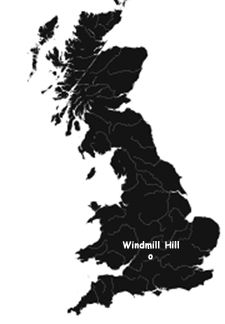 Windmill Hill near Avebury is a Neolithic causewayed enclosure, the largest example of its type in the U.K., containing three concentric but intermittent ditches. It encloses an area over 900,000 square feet.
Causewayed enclosures date from some time after the beginning of the Neolithic period (4000-2400 B.C.). They consist of a large central area surrounded by a series of ditches and banks. The ditches and banks are not continuous, and it is the spaces between them that give causewayed enclosures their name.
Windmill Hill was probably the first of the monuments to be built and used at Avebury. It was begun about 3700BC and completed within a remarkably short time, about 60 years. For about 350 years it was used intensively. During a later phase, ca.3300 B.C., three concentric segmented ditches were placed around the hilltop site, the outermost with a diameter of almost 1200 feet. The deepest ditches and largest banks are on the outer circuit.
About Windmill Hill (Avebury) Windmill Hill near Avebury is a Neolithic causewayed enclosure, the largest example of its type in the U.K., containing three concentric but intermittent ditches. It encloses an area over 900,000 square feet.
Causewayed enclosures date from some time after the beginning of the Neolithic period (4000-2400 B.C.). They consist of a large central area surrounded by a series of ditches and banks. The ditches and banks are not continuous, and it is the spaces between them that give causewayed enclosures their name.
Windmill Hill was probably the first of the monuments to be built and used at Avebury. It was begun about 3700BC and completed within a remarkably short time, about 60 years. For about 350 years it was used intensively. During a later phase, ca.3300 B.C., three concentric segmented ditches were placed around the hilltop site, the outermost with a diameter of almost 1200 feet. The deepest ditches and largest banks are on the outer circuit.
About Windmill Hill (Avebury)
Avebury Web: Windmill Hill
Megalithic Portal: Windmill Hill (Avebury)
Modern Antiquarian: Windmill Hill
Wikipedia: Windmill Hill, Avebury
Wikipedia: Causewayed Enclosure
Journey to Windmill Hill (Avebury)
Windmill Hill is located about three miles northwest of the village of Avebury in Wiltshiren in southwest England.
Ordnance Survey Map (SU0860271454)
Visitors Information
Visitors information for Windmill Hill (Avebury) may be found at the English Heritage website. For general tourism information for Wiltshire, see the Visit Wiltshire website.
Additional Photos of Windmill Hill (Avebury)
National Trust Sign Near Windmill Hill
Approaching Windmill Hill
One of Four Bronze Age Barrows on Windmill Hill
Portion of Ditch Surrounding One of the Barrows on Windmill Hill
Portion of Ditch Surrounding One of the Barrows on Windmill Hill
One of Four Bronze Age Barrows on Windmill Hill
One of Four Bronze Age Barrows on Windmill Hill
One of Four Bronze Age Barrows on Windmill Hill
Portion of the Outermost Ditch on Windmill Hill
|



